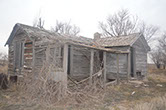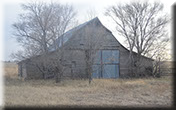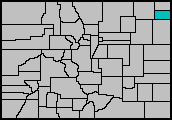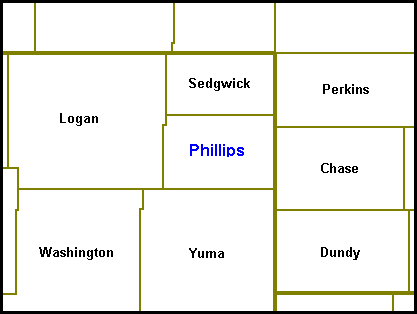

PHILLIPS COUNTY
Colorado
In the Beginning
Topographically speaking, the northeastern counties of Colorado were once the floor of a vast inland sea. Centuries ago geologic forces pushed the land mass up and west forming the Rocky Mountains, exposing it to glacial and weather erosion which formed the high plains
These high plains, the western edge of America’s Great Plains were filled with tall grass that supported millions of buffalo, deer, elk, antelope, wolves, coyotes, prairie dogs and other wildlife, birds and was described as flat, semi arid, and dotted with occasion buttes or other rocky outcroppings. If viewed from air, the countryside seems to run unending till it meets the sand hills to the southeast.
Originally this land was part of the Louisiana Purchase and was then only known as the “Great American Desert”. As Easterners started moving west, it became known as the Nebraska Territory and as these emigrants began to settle in and around the Rocky Mountains a new territory named, Jefferson was formed.
The land west of the Missouri was vast and inhabited only by wildlife and Indians. To stimulate the development of this area, President Lincoln signed The Homestead Act in May1862. This act allowed anyone over the age of 21 who was the head of the household, a legal resident, or who would declare his intentions of becoming a citizen to file a claim for a quarter section (160 acres) of unappropriated land.
As a condition of this ownership the claimant must live on the land and cultivate it for a period of 5 years. Another act called the Timber Culture, was enacted in March 1873, this act also granted the claimant title to 160 acres provided that the claimant would plan 40 acres with timber, with the trees being no more that twelve feet apart.
The Early Years
In 1861 the U.S. government officially recognized the territory and changed its name from Jefferson to Colorado, they appointed a governor and 17 counties were formed.
One of those counties was to have been called Platte County, but because the citizens never voted on it, the county was named Weld for the Territorial Secretary Ledyard Weld and it occupied the northeastern part of the new territory.
Colorado would officially become a state in 1876 and by 1889 the county of Logan would be carved from Weld and from it the counties of Phillips and Sedgwick were formed.
Phillips County was established on March 27, 1889 and was named for R.O. Phillips, a Secretary for the Lincoln Land Company. A hotel was built by William Clemmons and it soon became the first courthouse. It was located on the corner of Baxter and Interocean. Eventually Mr. Clemmons sold the building to the county in1901 for $850.00.
Of the two water course in the county, Wild Horse Creek and Frenchman Creek (River), the Frenchman River which is not considered a river until it enters Nebraska has an interesting story as to the origin of its name.
In the book SUTTONS SOUTHWEST NEBRASKA, Sutton gives this logical reason. ......
The story goes that a man by the name of Geminian Perry ( Jim Perry) ran a ranch/trading post called the “Star Trading Post”, at the old California Crossing of the Platte, 25 miles east of Julesburg. He had two sons, one white the other a half breed named Joseph Beavais.
As time went on and travel on the Oregon Trail slowed, Jim decided he wanted to move west, so he put his white son in charge of the trading post and soon established the Lone Star Ranche east of Ft Laramie. This angered Joseph, so he left the trading post and soon established himself a dugout 4 miles from Frenchman Falls (later Frenchman Cave) and another at the mouth of Bovau Canyon where he began trapping on what was to become known as Frenchman’s Creek.
The earlier name for this creek was Whiteman's Fork of the Republican. The name, Whitman’s Fork was explained by Capt. Eugene F Ware as the name given to this creek by the Sioux.
To the Sioux, Frenchman were white men and since white men were disliked by the Sioux they named the creek “WHA-SEECHA WOCCA-PELLA” with Wha means medicine, Seecha meaning bad .
No one knows for sure who was the first white man was to enter Phillips County, but in Vol.1 of the HISTORY OF COLORADO it is recorded that perhaps it was the Mallet Bros. The Mallet Bros were French trappers, who came up the South Platte, to the mouth of Lodgepole creek and then they turned south across the prairie, searching for a trade route to Santa Fe in 1739.
In Sutton’s book, Sutton tells of two stones being found on Leonard Sharpe’s farm south of Haxtun. These stones were inscribed with the date of June 10, 1787on them.
The Rocky Mountain News featured a story on them in 1953. It is believed that these stones were connected with the Remi La Doux expedition......
DEPARTMENT OF THE INTERIOR
U.S. GEOLOGICAL SURVEY
TO ACCOMPANY MAP 1-1894
HISTORIC TRAIL MAPS OF THE STERLING 1° X 2° QUADRANGLE,
NORTHEASTERN COLORADO
By Glenn R. Scott
1787, June 20
Two stones, fragments of the Ogallala Formation, have been found inscribed with the date Jun 20 1787 in the Sterling
quadrangle in T. 7 N., R. 47 W. (see pi. 1) and are in the museum of the Colorado Historical Society. Although the date seems to be in English style, E. S. Sutton, historian of Benkelman, Nebr.,has suggested that the stones might have
been carved by the following expedition:
A rumor exists that in the 1780's 300 men of a French expedition came to the Rocky Mountains. They found gold on present-day Treasure Mountain between Summitville and Wolf Creek Pass, in southern Colorado. The leader of the
expedition was called LeBreau, LeBreu, or LeBlanc; very likely his name was Remy (Remi) Ledoux.
After two seasons of mining gold, making gold ingots, and spending one winter in Taos, N. Mex., they turned east their party reduced to only 17 by an onset of scurvy. They crossed the mountains and went down the Arkansas River, where they were attacked by Indians several times and lost so many men that they were forced to hide the ingots. Ledoux was the only survivor.
In 1840, the grandson of Ledoux came from New Orleans, La. with a party of 40 to find the gold ingots but was
unsuccessful.


Some History

All materials contained on these pages are furnished for the free use of those engaged in researching their family origins. Any commercial use, without the consent of the host/author of these pages is prohibited. All images used on these pages were obtained from sources permitting free distribution, or generated by the author, and are subject to the same restrictions/permissions. All persons contributing material for posting on these pages does so in recognition of their free, non-commercial distribution, and further, is responsible to assure that no copyright is violated by their submission.
Last updated December 2018
